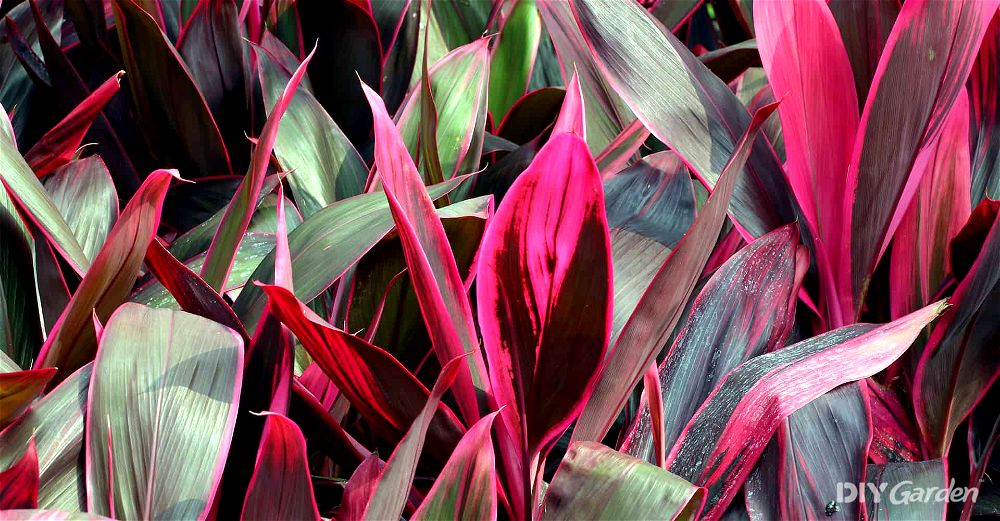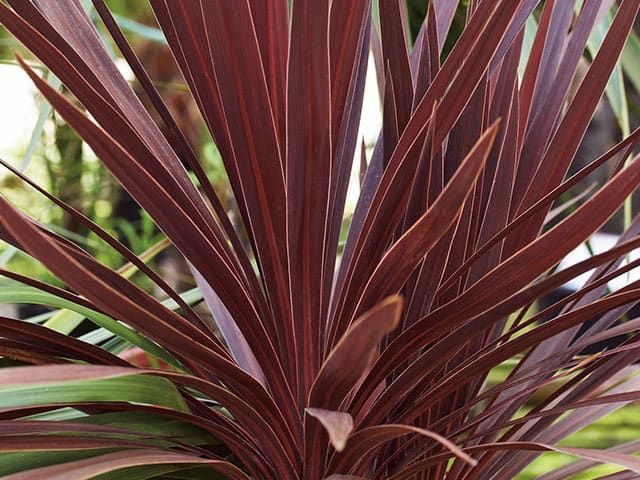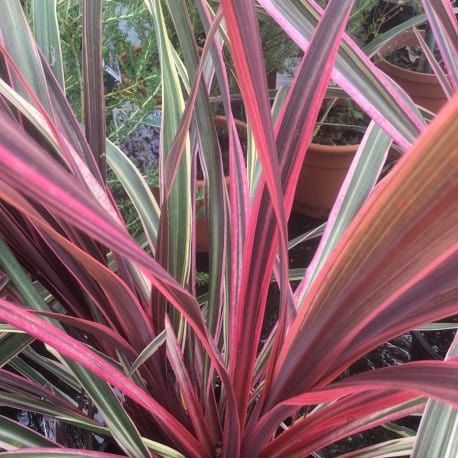
Jump to a Section
Plant Overview
| Common Name | Cordyline, Cabbage Palm |
|---|---|
| Scientific Name | Cordyline |
| Plant Family | Asparagaceae |
| Origin | These plants are native to New Zealand, eastern Australia, south-eastern Asia and Polynesia |
| Height | 3-10 metres (10-30 feet) or more |
| Light | Full sun to light shade |
| Temperature | C. Australis can tolerate temperatures of -5 but only if planted in a sheltered area. In coastal regions, it can cope well with temperatures as low as 1. More tender varieties will need to be protected in winter and kept at temperatures of 5-15°C |
| Hardiness | C. Australis are semi-hardy and will usually survive over winter in a sheltered spot. Other varieties are more tender and will need to be moved indoors or into a heated greenhouse in winter |
| Soil | These plants prefer fertile and well-drained soil |
| Fertiliser | Apply a well-balanced fertiliser in spring |
| Propagation | Suckers, terminal cuttings or seed |
| Pests | Mites, thrips |
| Difficulty | Easy |
Cordyline is an easy-to-grow plant that adds a tropical feel to the garden.
It looks equally good in city or coastal gardens and anywhere you want to add an element of the exotic. These plants are woody-stemmed shrubs, often grown for their attractive evergreen foliage. The sword-like leaves are shades of green, bronze, reddish orange and purple. As they grow, they lose their lower leaves and begin to look like stately palm trees.
Though these plants are grown for their architectural foliage, they produce spectacular clusters of white flowers in good summers. The flowers are followed by small red or purple berries.
Small young plants can be used in containers and bedding displays, while mature plants make a splendid feature growing up to ten metres in height. It may take 10 -20 years for Cordyline to reach its fully mature size. These plants are surprisingly hardy and will grow well in milder regions or in sheltered urban gardens. If grown in exposed sites they may need some winter protection.
Read on to find out how to choose and care for this lovely tropical plant.
Cordyline Care
These plants are relatively easy to grow and take little care and maintenance.
As they are only semi-hardy, some care should be taken to ensure they survive winter. Choosing a good location for these plants is key. They should be sited in a sunny, sheltered position out of strong winds and frost pockets.
Light Requirements
Cordyline does best in a sunny spot, though they can cope with semi-shade. Those with vibrant foliage should be planted out of scorching sunshine to prevent the leaf colour fading.
Water Requirements
Cordyline should not be allowed to completely dry out, especially in the growing season. Water them deeply rather than little and often. These plants can be damaged by fluoride, so if you live in an area where the tap water is high in fluoride you should water them with rainwater. Indoor plants can be watered with distilled water if necessary. Container grown plants will need regular watering in summer, but far less in winter when they are not growing. Avoid having your plant sit in cold, wet soil.
Soil Requirements
This plant will grow in sand, clay, chalk or loam. However, the ground should be well drained and reasonably fertile. In poor soil, dig in plenty of organic compost or well-rotted manure before planting. In heavy soils add plenty of grit.
Fertiliser Requirements
Plants in the ground should be given an application of well-balanced slow release fertiliser in spring. You can also supplement this with an extra liquid feed in June and July when they are growing at their strongest. Container-grown cordyline should be fed with a liquid fertiliser monthly during the growing season, usually late spring to late summer.
Planting
These shrubs should be planted out in spring. This allows them to get established before cold winter weather.
If planting in a container, use a loam-based compost such as John Innes No 3. It is wise to add some horticultural grit to improve drainage as these plants do not like to sit in wet soil.
If planting in the ground, it is worth digging in some well-rotted manure before planting as these are quite hungry plants. If drainage is poor, add plenty of horticultural grit.
Dig a hole twice the width of the rootball and place the plant at the same level as it was in the pot. Backfill and water well. You might like to add a layer of mulch to suppress weeds and retain moisture.
They will not need any support.
Maintenance
These plants do not require much maintenance beyond removing dead leaves, damaged stems and spent flowers. However, some care should be taken to provide winter protection. If you live in a mild area and have a sheltered garden, then a thick mulch may be all that is required. You can also tie up the foliage to prevent wind damage and to prevent water from settling in the crown. Use a soft material, an old pair of tights is perfect, to ensure you do not damage the leaves. Make sure the plant is fairly dry before you do this, as if tied up when wet they may rot.
If you live in a colder region of the UK or garden on an exposed site, your cordyline may need some extra winter protection. In addition to tying up the foliage, it may be necessary to wrap the plant in fleece.
Container-grown plants can be moved into a greenhouse or indoors. Alternatively, wrap the pot in bubble wrap and the foliage in fleece and place the pot in a sheltered location such as against a wall.
Tender species such as C. Marginata, C. Stricta and C. Fruticosa will need to be moved indoors or placed in a heated greenhouse with a minimum temperature of around 15°C.
Repotting
Your cordyline should be repotted once the roots fill the current pot. Choose a pot only slightly larger than the existing one and use plenty of fresh loam-based compost. If the plant does not need repotting, remove the top few centimetres of soil and replace it with fresh to keep your plant in good condition.
Looks Good With
Cordylines add all round interest to the garden and suit a variety of styles. They are striking architectural plants that look good with other tropical-style plants and softer grasses.
In a tropical style border, they can be teamed with flowering plants such as crocosmia, red hot pokers, hostas or canna lilies.
The spiky leaves contrast well with more rounded tropical-style shrubs such as fatsia japonica.
In a more traditional border, they also add colour and form and as they mature they make a great alternative to a standard specimen tree, especially in the smaller garden.
In a city garden, these plants look great in containers and pots adding some vibrancy and interest to seating areas, patios and balconies. They look stunning when planted in a modern container topped with slate chippings or pebbles. Planting them in groups show off their different forms. Alternatively, add pots of tropical looking flowers such as Canna lilies, Clianthus and Sophora.
Pruning advice
Cordylines require little pruning, simply remove dead leaves and spent flowers. You can also remove any stems or leaves that have suffered winter damage. It is best to wait until the harshest weather is over before doing this.
If your plant has become a bit straggly you can prune it to get a better shape. This is best done in mid-spring. Cut back to side shoots, basal shoots or even ground level. After pruning this harshly it is wise to apply a well-balanced fertiliser to encourage new growth.
Cordyline Propagation
You can propagate Cordyline from suckers, terminal cuttings or seed:
Propagating Cordyline From Suckers
In spring you may see rooted suckers arise from the base of the plant. These can be removed and potted up to provide new plants. It is often wise to overwinter the new plant in a greenhouse before hardening off in spring.
Propagating Cordyline From Terminal Cuttings
To take terminal cuttings you should remove a stem with a terminal bud or growing point at the tip and several buds along the stem. Cut it to about 10 – 15 cm (4-6 inches). Make the cut just below a leaf node.
Remove the lower leaves, dip the stem in hormone rooting compost and insert into pots of potting compost mixed with horticultural grit. Mist well with water. Cover the pot with a large plastic bag to help retain moisture. Place the pots in a sheltered warm spot.
Check the plants weekly and water them, remove any dead plant material and give them an airing.
Propagating Cordyline From Seed
Cordylines grow well from seed. The seeds should be sown in spring once the weather has warmed up. For best results start them in a propagator and then move them to a bright, sheltered spot once the weather is warm. Once the seedlings are large enough to handle, pot them up individually.
The plants should be overwintered in a greenhouse ready for planting out the following spring.
Cordyline Problems
Cordylines are not particularly susceptible to many pests and diseases. Given the right growing conditions, they should not give you much trouble at all. If you do notice any problems, then check the following section to find out what is affecting your plant and how to deal with it.
Pests
There are a couple of pests that can cause problems for Cordyline plants. The two most common are mites and thrips.
Mites
Occasionally your plant may be affected by mites such as the spider mite. These tiny insects suck the sap of your plant. They’re hard to see, though you may see their webbing. The symptoms of a mite infestation include discoloured and distorted leaves. Regular watering should help. You can also knock off the mites with a jet of water. Do this early in the day so that the leaves have a chance to dry out.
Thrips
These sap-sucking insects can cause discolouration and scarring on the leaves as well as generally stunted growth. Cut out any severely affected parts of the plant and destroy the material. You can then spray the rest of the plant with insecticidal soap. Encouraging beneficial predators such as ladybirds and lacewings can help keep the population of thrips down.
Diseases
Cordylines can be susceptible to a few different diseases, these are the ones that most commonly cause problems:
Leaf Spot
Fungal leaf spot diseases can cause discolouration of the leaves. To prevent this problem, water the roots of the plant rather than the leaves or stem. Water early in the day so that any water that splashed the leaves has a chance to dry out before the temperature cools. It is also good to ensure plenty of air circulation around the plant.
If your plant is affected, remove the damaged growth and destroy it. Disinfect your tools after doing this to prevent spreading the problem. A fungicide may be used for severely affected plants.
Root Rot
Root and stem rot can be caused by the Fusarium pathogen. This is often caused by excessive watering or poor drainage. Allow plants to almost dry out before watering so that the roots are not sitting in wet soil. Avoid watering the stem itself and direct the water at the root area.
Cordyline Slime Flux
This disease is caused by a bacterium that gets into the plant after it has been damaged by frost.
In very cold weather, water in the stems, leaves and roots of your plant may freeze causing tissue damage. These damaged areas allow bacteria to enter the plant. If your plant is affected, you may see oozing white thick fluid on the stem of the plant. This will have a foul smell. There may also be black staining below the fluid. You should cut away and destroy any affected parts along with any damaged tissue that may allow more bacteria in.
The best defence against this disease is to protect your plant in winter.
Cordyline Varieties
There are several varieties of Cordyline but only C. Australis is hardy enough to be grown outdoors in this country.
Besides this, there are cultivar varieties which are slightly smaller, have different coloured leaves, and are often not quite as hardy. With care they can also survive outdoors. Then there are more tender varieties that can be grown in containers and moved into a greenhouse, conservatory or indoors in the winter. More tender species will need minimum temperatures of 5-15°C.
C. Australis
C. Australis is a green-leaved variety. It reaches a height of 3-10 metres (10-30 feet) when mature. This plant is hardy enough to be grown outside in the UK.
C. Australis ‘Albertii’
This is a cultivar variety. It has three colours and often combines green leaves with a pinkish-red stripe down the centre, cream stripes and pink edges. It reaches a mature height of around 4 metres (13 feet).
C. Australis ‘Torbay Dazzler’
This cultivar variety has green leaves with cream stripes which can be up to 60 cm in length. It reaches an ultimate height of 4 metres (13 feet).
C. Australis ‘Sundance’
This cultivar variety has green leaves that are striped with red at the centre. It reaches a mature height of around 4 metres (13 feet).
Less Hardy Varieties
Worth considering, but requiring slightly more work than C. Australis, are these tender varietes:
- C. Marginata
- C. Stricta
- C. Fruticosa
You should plant these less hardy varieties in containers so they can be moved indoors or into a heated greenhouse in winter. These vibrant exotic plants look wonderful in a seating area and add a nice tropical feel to the summer garden. They also make lovely houseplants. C. fruticosa is particularly lovely and comes in plain green, tricolour or red edged varieties. The red-edged version is exceptionally stunning.
FAQs
It sounds like your plant may be suffering from fluoride toxicity. Cordyline are very sensitive to fluoride and it can cause browning of the tips of the leaves and, eventually, the leaves become mottled all over and die. If you are watering your plant with tap water this may be what is causing the discolouration. Try watering your plant with rain water or distilled water. You should also make sure you keep the soil moist at all times.
It sounds like your plant is thirsty. You should water your plants regularly and deeply. The soil around them should be constantly moist but not sodden. Regular deep watering is better than frequent sprinklings. Container-grown plants should be watered until the water starts to come out of the drainage holes. The pot should then be left until it is almost, but not entirely, dry before watering again.
This sound like winter damage. After a harsh winter, cordyline can look quite battered, especially if there have been extreme cold snaps, hail or strong winds. In future, you might like to protect your plant’s foliage by tying it up and/or covering it with fleece. Your plant should perk up once the weather warms. You can cut away any damaged growth and apply a fertilizer to see if this perks you plant up. After that, if you notice discolouring of more leaves, check for pests and diseases.



Share